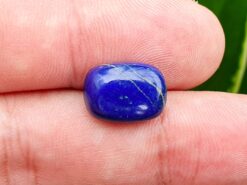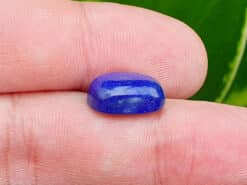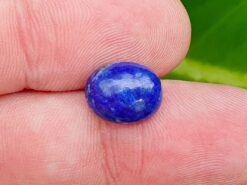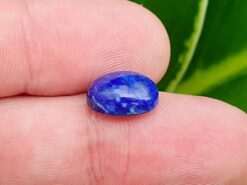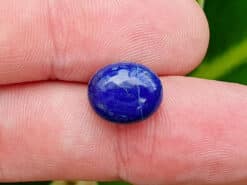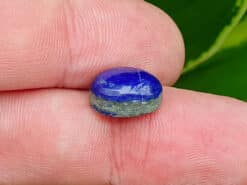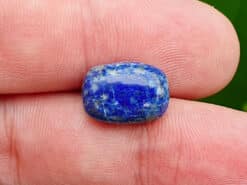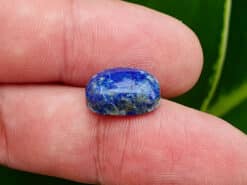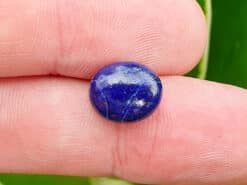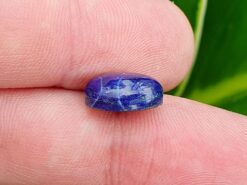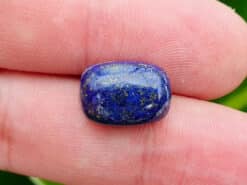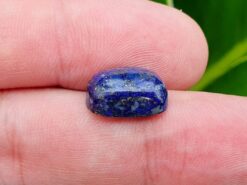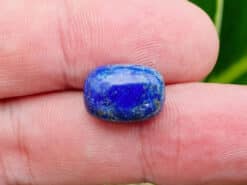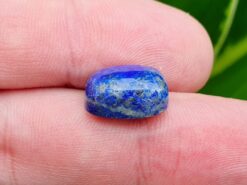Lapis lazuli

Lapis lazuli stone meaning and benefit. A feldspathoid silicate mineral lazurite. Not to be confused with the gemstone lazulit.
Buy natural lapis lazuli in our shop
Lapis lazuli meaning. The most important mineral component is lazurite, a feldspathoid silicate mineral. It also contains calcite, sodalite, and pyrite. Some samples contains augite, diopside, enstatite, mica, hauynite, hornblende, nosean, and sulfur-rich lollingite geyerite. The stone usually occurs in crystalline marble as a result of contact metamorphism. Not to be confused with lazulit.
Color
The intense blue color is due to the presence of the trisulfur radical anion in the crystal. An electronic excitation of one electron from the highest doubly filled molecular orbital into the lowest singly occupied orbital
Sources
We find Lapis lazuli stone in limestone in the Kokcha River. A valley of Badakhshan province in northeastern Afghanistan. Where the Sar-e-Sang mine deposits are open for more than 6,000 years. Afghanistan was the source of lapis for the ancient Egyptian.
And Mesopotamian civilizations, as well as the later Greeks and Romans. Ancient Egyptians obtained this material through trade from Afghanistan with the Aryans. During the height of the Indus Valley Civilisation about 2000 BC. The Harappan colony (Shortugai) was established near the lapis mines.
According to the Sorbonne’s mineralogist Pierre Bariand’s. Leading work on the sources in modern times. And to references in Afghanistan’s Blue Treasure: Lapis lazulit (2011) by Lailee McNair Bakhtiar. It is found in “caves”, not in traditional “mines”. And the stone is from the primary source of the Hindu Kush Mountains. In Afghanistan’s Kochka River Valley.
In addition to the Afghan deposits, we found lapis in the Andes. Near Ovalle, Chile, and to the west of Lake Baikal in Siberia, Russia, at the Tultui Lazurite deposit. Smaller quantities are also avalaible in Angola, Argentina, Burma, Pakistan, Canada, Italy, India, and in the United States in California and Colorado.
Uses and substitutes
Not to be confused with lazulit, lapis takes an excellent polish. We can use it in jewelry, also carvings, boxes, mosaics, ornaments, small statues, and vases.
During the Renaissance, Lapis was ground and processed to make the pigment ultramarine. For use in frescoes and oil painting. Its usage as a pigment in oil paint largely ended in the early 19th century. When a chemically identical synthetic variety became available.
Lapis lazuli meaning
The following section is pseudo scientific and based on cultural beliefs.
One of the most sought after stones in use since man’s history began. Its deep, celestial blue remains the symbol of royalty and honor, gods and power, spirit and vision. It is a universal symbol of wisdom and truth.
FAQ
What is the spiritual meaning of lapis lazuli?
The Sumerians believed that the spirit of their gods lived within the stone, while the ancient Egyptians saw it as a symbol of the night sky. Since the earliest of times, lapis lazulit has been associated with strength and courage, royalty and wisdom, intellect and truth.
What are the healing properties of lapis lazuli?
The stone boosts the immune system, purifies blood, lowers blood pressure, cooling and soothing areas of inflammation. It alleviates insomnia and vertigo, and overcomes depression.
What chakra is lapis lazuli?
The stone of wisdom and is perfect for Third Eye Chakra. The Throat Chakra is the voice of the body. If it is blocked or out of balance, it can affect the health of the other Chakras.
How much does lapis lazuli cost?
It is not an expensive stone, but truly fine material is still rare. Lower grades may sell for less than $1 per carat, while the superfine material may reach $100–150/ct. or more at retail.
Who should wear lapis lazuli?
Love and Relationships. When it comes to love and relationships, the gemstone is basically a woman’s best friend. It brings energies of wisdom, love, and emotional healing to the person who wears it or keeps it close to their bodies.
What is the power of lapis lazuli?
In terms of mental healing and emotional powers, the stone carries positive energy and can strengthen the mind, helping its wearer to overcome issues relating to trauma, depression or grief. It can help its wearer to declutter their mind, think more clearly and bring about inner hope and courage.
Does lapis lazuli need to be cleansed?
Cleanse your crystal by holding it under running lukewarm water. Since it is fairly soft, it should not be soaked in water for a long period of time. After cleansing, dry the stone immediately and thoroughly.
Natural lapis lazuli for sale in our gem shop
We make custom made lapis lazuli jewelry as engagement rings, necklaces, stud earrings, bracelets, pendants… Please contact us for a quote.

